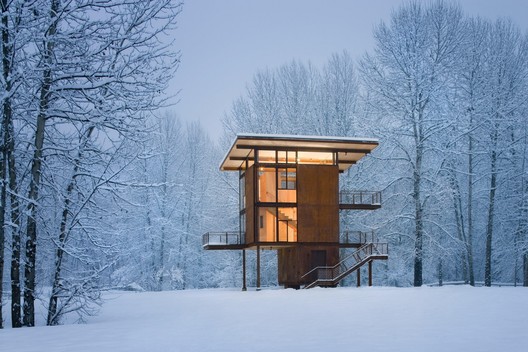
-
Architects: Olson Kundig
- Area: 1000 m²
- Year: 2005
-
Manufacturers: AEP Span, Cassina, Ceco Door, Chista, Farwest Ironwork, Fleetwood, Knoll International, Leaf Chair, Milgard, Poltrona Frau, Weyerhaeuser

Text description provided by the architects. Delta Shelter – a 1,000 square-foot cabin – is essentially a steel-clad box on stilts that can be completely shuttered when the owner is away. The 200 square-foot footprint of the house rises above a 40-acre, 100-year flood plain adjacent to the Methow River. The verticality, coloring and raw nature of the materials used for construction directly respond to the wildness of the setting. The owner sought a compact, easy to maintain, virtually indestructible building to house himself and his friends for fun and adventure in the mountains. With an exterior of steel, the house is virtually indestructible.

The cabin is composed of three levels: the lowest level is half carport, half utility/storage room; the middle level consists of the entry, two small bedrooms and bathrooms; the top level is one large space which includes living, dining and cooking areas. Cantilevered steel decks extend from the top and middle levels and provide space for outdoor sleeping and entertaining.

The cabin is supported by four steel columns. Floors are 3” x 6” tongue-and-groove wood car-decking, and exterior wood infill walls are clad in 16-gauge, hot-rolled steel sheets with exposed steel fasteners. Most of the structure, including the steel structure, roof panels, shutters, and stairs, was prefabricated off-site, thereby reducing on-site waste and site disruption.

Due to prefabrication and the use of plywood for all interior surfaces, typical construction wastage was kept to a minimum. Aside from building as small a structure as possible and limiting the impact on the landscape, Delta Shelter’s most unique sustainable strategy was to be able to open the structure to the environment and to use human power as the means to do it.


All four shutters, which measure 10’ x 18’, can be opened and closed simultaneously by using a hand wheel that moves the shutters over the glazed portions of each façade. The shutters are operated by a series of mechanical devices including a hand wheel, drive shafts, u-joints, spur gears and cables. All windows are operable. No air conditioning is included in the project.












































